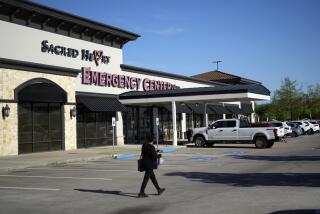Pinched Public Hospitals in Need of Resuscitation
- Share via
DALLAS — Adam Fira found himself in a hospital room after a car crash last year with half his skull missing and his head sunken in like a deflated basketball.
The high school football player couldn’t run, lift weights or wrestle with his sisters. The slightest bump or fall could harm his brain, protected only by skin etched with a road map of pink scars.
For months, he wore a skateboarding helmet to school and waited for doctors at Parkland Memorial Hospital to schedule surgery to implant a plastic skull.
Doctors said it might happen before Christmas, but it didn’t. When it was delayed again in May, the handsome, popular athlete lost confidence. He stopped talking to friends. He stopped leaving the house.
Finally, on July 12, the phone rang. Parkland had scheduled surgery for the next morning. Fira’s mother used up her cellphone minutes spreading the news to family, coaches and church members. Her son couldn’t sleep that night. His stomach churned as it used to on Fridays before games. Before dawn, they drove two hours from the small town of Hillsboro to Parkland.
In room 229, his black curls shaved, stomach empty, an IV in his arm and 15 relatives camped out nearby, Fira waited for his new skull.
Hours went by. Noon passed. Another soap opera droned on TV. Fira grew more hungry and frustrated the longer he waited.
After 13 hours, doctors told him to go home. Another patient’s aneurysm and other emergencies at the public hospital had tied up doctors and operating rooms all day. Fira’s surgery, considered elective, would have to wait.
“I didn’t want to believe them,” said Fira, now 18. “I could have exploded, but that wouldn’t have done anything.”
Fira’s experience is common at Dallas County’s only public hospital, even though he is among the 7% of its patients with insurance. That makes him one of the few paying customers of a hospital in desperate need of more money.
Because Parkland doctors saved his life, Fira’s parents wanted his surgery done there.
The financial crisis that erodes patient care and, some doctors say, threatens lives at Parkland is part of a larger crisis threatening to unravel safety net healthcare at many of the 1,100 public hospitals throughout the country.
Since their origins in the 1700s as almshouses and sanitariums, public hospitals have relied on taxpayer dollars to provide care to Americans who couldn’t afford it otherwise.
Some, like Parkland, branched out over the years, teaming with medical schools to become state-of-the-art teaching institutions that draw patients who could afford to go elsewhere. In some cases, public hospitals offer the only top-level trauma or burn care in a region.
But in recent years, public hospitals have been hit hard by government healthcare cuts, just as surging numbers of uninsured Americans and illegal immigrants are turning to them for care.
Nearly 82 million people -- one-third of the U.S. population under 65 -- lacked health insurance at some point over the last two years, according to a recent study by Families USA, a private consumer group. Texas had the highest rate in the nation, with more than 43% of its non-elderly population uninsured.
The National Assn. of Public Hospitals and Health Systems says about half of its 100-plus members lost money in 2002, the latest data available. Many are cutting jobs, closing clinics and postponing surgeries to keep the doors open.
“The situation, which is generally always grim, is even grimmer now,” said Rick Wade, a spokesman for the American Hospital Assn. “You look at every part of the public healthcare system and you see enormous strain and you see everybody hollering for help. And the answer is unclear.”
And patients, it seems, are paying the price.
*
At Parkland, which delivered nearly 16,000 babies last year, women are giving birth in the hallways. In the emergency room remembered throughout the nation as the place where President Kennedy was taken after he was shot, patients without life-threatening injuries wait an average of 7 1/2 hours for care. They get in line before dawn to pick up prescriptions.
A woman with a lump in her breast can wait three months for a biopsy. Dying cancer patients are spending their last days waiting up to 10 hours for chemotherapy in a cramped room where some sit in office chairs for lack of recliners. In the operating room, which does about 15,300 surgeries per year, patients wait eight months for gall bladder surgery.
Like triage on the battlefield, doctors and nurses ration the hospital’s shrinking resources and space. They take care of the car crashes, the gunshot victims, the patients closest to death and they put off the rest.
“Anything that can be delayed will be delayed,” says Dr. Ron Anderson, Parkland’s chief executive officer for 22 years.
Parkland is the primary teaching facility of the University of Texas Southwestern Medical Center at Dallas, which touts four Nobel laureates, more than any other medical school in the world. And under Anderson’s leadership, Parkland has made U.S. News & World Report’s best hospitals list for the last 11 years.
The quality of the staff remains the best, Anderson says, and many patients agree.
But Anderson believes Parkland is facing the most dire moment of his tenure. Without new funding, patient care will suffer, along with the hospital’s proud reputation.
Parkland and its clinics reported more than 849,000 patient visits last year. Ninety-three percent of those treated had no private insurance -- nearly 40% couldn’t pay, and the rest were on Medicare or Medicaid.
About 4% of Parkland’s $812 million operating expenses went toward unpaid medical bills of patients from nearby counties without public hospitals. The Parkland system also lost about $74 million in state and federal funding for 2004-05. To help compensate, it eliminated about 500 jobs.
Still Parkland refuses to turn patients away.
“Sometimes, the crisis isn’t in public view; it’s pushed downstream. But nevertheless it happens, and I think it’s time to tell people,” Anderson said. “There’s a point where it’s going to become unsafe. It already has, in some ways.”
*
Paula Holland would agree. She’s been waiting more than a year to have a brain tumor removed.
Holland said doctors told her that the mass woven deep beneath her long silver hair has coiled itself around a band of nerves above her neck, strangling her vocal chords and pinching her voice to a rasp. Her headaches get worse. She can’t remember easy things such as her sister’s longtime phone number.
If she doesn’t have surgery soon, doctors told her recently, it could affect her hearing and her ability to swallow.
Doctors at a private hospital in Dallas discovered the tumor and another one behind her eye in October 2002 after she nearly died from a brain aneurysm. They referred her to the neurosurgeons at Parkland, who removed the tumor behind her eye but haven’t gotten to the other one.
“It’s always something. One thing or another. They keep putting it off,” said Holland, 47, a former volunteer firefighter. “It’s mentally draining.”
Over the last year, Holland said she had seen about 20 doctors in several different Parkland clinics. She waits five, maybe six hours each time to spend 10 minutes with a doctor who always seems rushed.
“It’s kind of like cattle. They run you in and run you out, except you wait for hours in between.”
They say she needs surgery and suggest it is coming soon. They will call, they say, but seldom do. She would like to go somewhere else, but she lost her private insurance, and as a Medicaid patient, her options are few.
“Put yourself in my shoes: They tell you have a brain tumor and the first thing that enters your brain is, ‘Oh my God, I’m going to die,’ ” Holland said. “Then they tell you they’re going to set a date and then they don’t.”
A hospital official familiar with Holland’s case said doctors would have operated sooner if the tumor were growing rapidly or threatening her sight, but its size hasn’t changed.
Meanwhile, the monster living in her head is a mystery. She doesn’t know how big it is or how long it has been there.
The hardest part is she won’t know if it’s cancer until they operate.
“I try not to think about that,” she says, hiding her tears with her hands. “I just try to think it’s not going to be cancer.”
*
Paulette Cano knows the cancer has already won.
By the time she came to Parkland in late 2002, she was terminal.
She would like to spend her time left planting flowers, reading Dean Koontz or enjoying her very own tub of Blue Bell ice cream. Instead, she’s in a row of cancer patients, waiting sometimes 10 hours for her chemotherapy treatment.
“You know you’re going to die,” says Cano, 62. “And you’re losing a whole day basically just waiting.”
The former legal secretary lost her health insurance when she could no longer work. Now on Medicaid, she said Parkland was her only option.
It takes only 15 minutes for the drugs to flow from the clear bag into her frail body, hunched in an office chair with rollers. And the nurses are good.
“These ladies, bless their heart, they’re falling all over themselves because there’s no room for us,” she says.
The chemo is supposed to buy her time and keep her comfortable. But she’s losing time in the process.
“It kind of makes me mad because I worked since I was 15 and paid taxes and probably helped build the first Parkland,” she says. “I think, ‘You know, it’s my turn. Why can’t they do something for me?’ ”
*
Fira, the teenager waiting for skull surgery, could have gone elsewhere. But his mother, Christina Lopez, wanted the surgeons who started the job to finish it. She understood the hospital’s need to treat life-threatening injuries first, but it made her angry that the hospital considered her son’s surgery elective.
After Parkland rescheduled the surgery in July -- another false start -- Lopez got her son referred to a private hospital. The next day he was in surgery at Zale Lipshy University Hospital, just down the road.
“They got in there. They got the job done,” said Fira’s mother.
Although she still raves about Parkland’s trauma care, she regrets not going to a private hospital sooner.
Fira’s back at school, a few weeks into his senior year. He’s lifting weights, running a bit and trying to get in shape to play basketball this season.
“For the past year, we’ve had Adam, but we haven’t really had Adam,” Lopez says. At least now, “Socially, he’s himself again. He’s not ashamed in any shape or form.”
She wishes he could have gotten there sooner.
More to Read
Sign up for Essential California
The most important California stories and recommendations in your inbox every morning.
You may occasionally receive promotional content from the Los Angeles Times.










